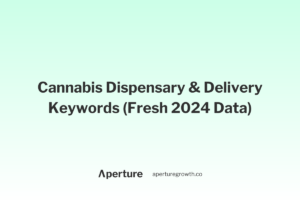If you own a CBD store or are in charge of marketing for one, you have a singular goal: get more people in your store. Do this, or you’re cooked.
To do this, you need people in your area to a) know you exist and b) want to visit your store.
To fulfill this goal, you can either:
- Generate demand for your store
- Get people who already have demand for CBD in your area to visit your store
CBD stores should do both. To the end of demand generation, you might already be attending local festivals and farmer’s markets, posting in local Facebook groups, and purchasing billboards to stir up demand for your business.
Where most CBD stores go wrong is ignoring the existing demand for their products. Demand probably already exists: I can just about guarantee you that people in your area are searching for nearby CBD stores on Google and other search engines.
Therefore, you’ll want to ensure that your business shows up at the top when people search things like “cbd store near me.” And the way this happens is local SEO.
Implementing a robust CBD local SEO strategy allows your business to become more visible to people who are already looking to visit a store like yours, instead of trying to compete for the attention of people who haven’t even shown an interest in CBD products.
In this article, I’m going to lay out the exact local SEO strategy our agency uses to drive foot traffic for our CBD clients. Let’s get into it.
What is Local SEO & Why Does It Matter for CBD Stores?
Local SEO is a type of search engine optimization (SEO) strategy that helps businesses improve their visibility on Google for local search terms.
Local search terms are those which indicate someone is looking for something specific to a geographic location (usually their location).
For example, someone searching “coffee near me” is trying to find a coffee spot near them. When they perform that search, Google will recommend places that are near the searcher’s physical location.
Investing in local SEO makes sense because lots of people use Google to find businesses, and many of those who do end up completing purchases.
A 2016 study by Google found that 76% of people who perform a local search on their smartphone end up visiting a local business in 24 hours or less, and 26% of those searches (not visits from searches, but the searches themselves) result in a purchase.
All this to say: if your CBD store can rank high on Google for keywords like “cbd store near me,” organic search can quickly turn into a significant source of foot traffic and revenue.
Good local SEO focuses on getting these rankings.
Local SEO vs. “Traditional” SEO
The difference between local SEO and traditional SEO is simple:
- Local SEO focuses on achieving more visibility for search terms that indicate someone is looking for something in their local area (“cbd store near me” “cbd store [city] [state]’)
- “Traditional” SEO focuses on being more visible for search terms that aren’t tied to a geographic area (“buy cbd online” or “cbd cbg gummies”)
If your business has physical retail locations and sells products online, both types of SEO are important.
That being said, there’s a lot to cover for each, so I’m only going to discuss our local strategies in this article.
Local SEO for CBD Brands: The Strategy
The goal of any SEO strategy – local or not – should be to drive revenue.
For local SOE, the intermediate goal is to drive foot traffic to your brick-and-mortar CBD store(s).
To do this, you’ll need to rank for keywords that have visiting intent. Visiting intent keywords are those which indicate someone intends to visit a local business.
High visibility for these terms converts to foot traffic for your CBD store, while visibility for non-visiting-intent keywords does not.
Our agency employs a six-pillar local SEO framework to help our brick-and-mortar CBD clients rank for visiting-intent keywords and increase their foot traffic:
- Google Business Profile(s)
- NAP citations
- Location pages
- Blog content
- Link building
- Technical SEO
To be clear, this is a strategic framework, NOT a strategy. Your strategy should be unique to your target customer, the problems you solve for your target audience, and the way you solve those problems (practically speaking, your product line).
That being said, most successful CBD local SEO strategies will include some or all of these tactics put together.
Pillar 1: Google Business Profile
Business Profiles are a feature that Google displays in their search results when someone searches with the intent of finding a nearby business.
Business Profiles contain information about a business like their address, phone numbers, hours, website, and more. They also give people a place to leave reviews of the business (and read them).
Google automatically creates these profiles when they learn of the existence of a business. These profiles can be claimed by businesses themselves or created by a business if Google hasn’t created one for them.
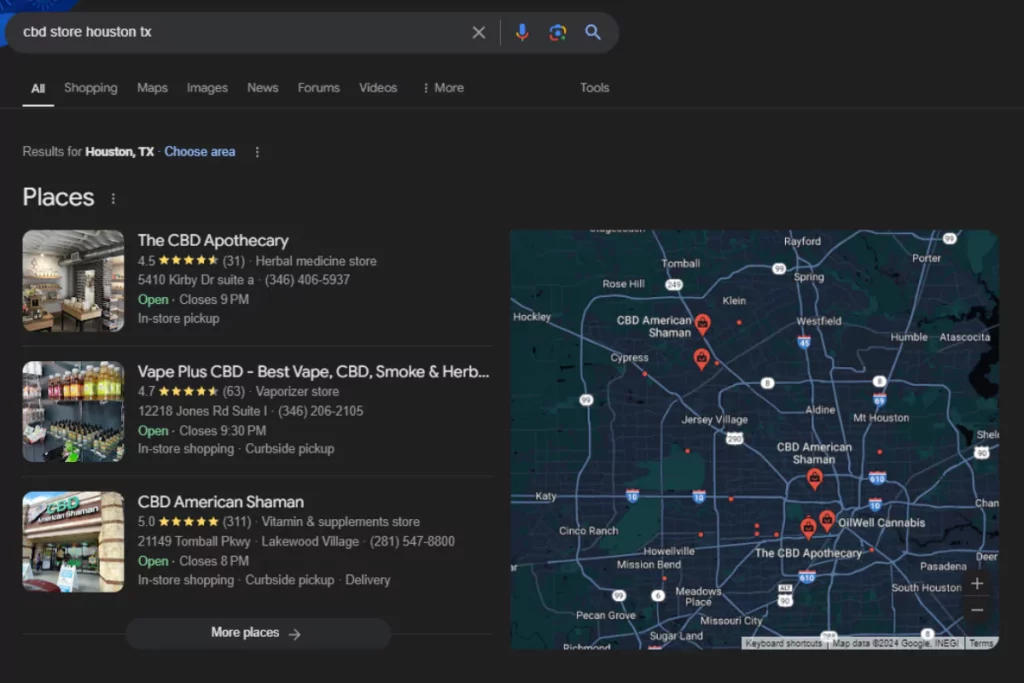
How it works
Through their Map Pack search feature, Google displays Business Profiles that are the best matches when people search visiting-intent keywords, which, as I mentioned earlier, are the most important for CBD stores.
If your CBD store’s Google Business Profile(s) (GBP) are well-optimized, you’ll have a better chance at showing up at the top of the Map Pack feature when people search things like “cbd store near me.”
In most cases, people won’t be running ads for these search terms, so a #1 ranking in the Map Pack means you’ll be at the very top of the page, period.
Because of this, ranking your GBP should be your primary focus when doing local SEO.
How to do it
To best optimize your GBP, it helps to understand what Google looks for when deciding in what order to rank profiles for a given search query.
Google considers the following factors:
- Relevance: How well a local Business Profile matches what someone is searching for.
- Distance: How far each potential search result is from the location term used in a search.
- Prominence: How well known a business is. Some places are more prominent in the offline world, and search results try to reflect this in local ranking. Prominence is also based on information that Google has about a business, from across the web, like links, articles, and directories. Google review count and review score factor into local search ranking. More reviews and positive ratings can improve your business’ local ranking. Your position in web results is also a factor, so search engine optimization (SEO) best practices apply.
By virtue of having a brick-and-mortar CBD store in the area where a searcher is, you can fulfill factors #1 and #2 just by completing your Google Business Profile.
But factor #3 – prominence – is where things get more difficult: how do you indicate to Google that your business is legitimate, well-known, and authoritative?
Much of local SEO is about answering this question, and therefore involves doing things that increase your business’s online credibility, authority, and visibility. Some of it involves your GBP, but much of it does not.
Below are some tips for optimizing your GBP to best fulfill these three factors (I’m not going to give you an exhaustive step-by-step guide to completing your GBP, as much of it is common-sense – see this article from Mailchimp for more).
- List a local phone number. If you use a different number for call tracking, set that number as the primary number and put your local number in the secondary number slot.
- Upload plenty of high-resolution photos. You’ll want to add images of your business’ exterior, interior, and products. Preferably, your images have people in them (this is more about appealing to humans than optimizing for Google).
- Focus on obtaining good reviews. Make an effort to get reviews on your Google Business Profile from your customers. This will increase your visibility and increase the chance that someone who sees your profile will end up visiting your location. Also, be sure to respond to reviews to demonstrate that you value your customers and their feedback.
- Link to corresponding location pages. If you have multiple locations and you’ve built search-optimized location pages (see pillar 3) for each, set these URLs, instead of your homepage URL, as the website for each location. This will improve the ranking of your GBPs.
- Fill out the questions and answers section. GBPs offer a place to address common questions people have about your business. This reduces the uncertainty people have about visiting your store and gets rid of some of the need to call or message your business. This will keep people from visiting another business because they’re unsure whether your business has what they need.
- Post content on your GBPs. Google allows you to post on your GBP, and these posts show up at the bottom of your full profile in search (which usually shows when someone types your brand name) or when someone clicks your profile in the Map Pack. In this section, you’ll want to post about sales and promotions as people will see these posts before ever reaching your site or visiting your store; if you have an in-store deal going on, it may influence someone’s decision to visit you at that moment.
Pillar 2: NAP Citations
NAP stands for Name, Address, and Phone Number. A NAP citation is when another website lists your NAP.
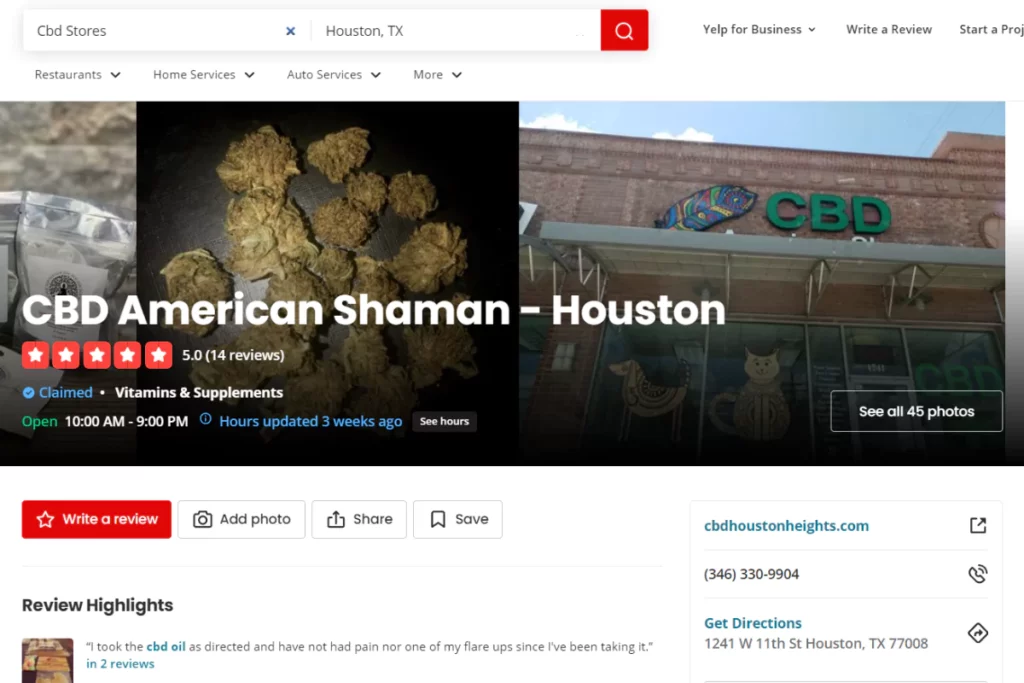
How it works
To customers, the NAP is the most important piece of information about your business:
- Unless someone knows your NAP (i.e. what you’re called, where you are, and how to get in touch with you), they won’t be able to do business with you.
- More generally, the presence of a NAP shows that your business actually exists and is servicing customers.
Therefore, when determining your rank in the Map Pack, Google places a lot of emphasis on whether the NAP listed on your GBP is correct.
NAP citations are the primary way Google verifies if your NAP is correct. Google views these citations as votes from third-party websites that indicate your business’s NAP is what you claim it to be.
As a result, the more NAP citations your CBD store can get from other websites that match with your GBP, the better you’ll rank in the Map Pack – and the more foot traffic you’ll get.
How to do it
When it comes to NAP citations for your CBD company, you’ll want to do two main things:
- Audit existing citations and request corrections as needed
- Get new citations from key websites
You’ll want to do both of these steps for each of your locations if you have multiple.
To do the first step, you can simply input your name, address, and phone number into Google search and manually check all of the listings you find to ensure they match what’s on your GBP.
For step two, you’ll want to submit your citations to data aggregators, major directory sites, and industry and local sites.
Some of these sites allow you to sign up and create a NAP listing on your own, while for others, you’ll need to get in touch to have your NAP added or changed.
Below is a brief description of each type of site, as well as key sites to pay attention to within each category:
- Data aggregators: These sites collect and distribute information to sites.
- Express Update
- Neustar localeze
- Factual
- Major directory sites: These sites contain certain types of information about businesses and are visited by many people; you’ll want to ensure the information on them is correct.
- Apple Maps
- Yelp
- Bing Places
- YellowPages
- Better Business Bureau
- Foursquare
- Local sites: These are sites in your industry or locality that list businesses like yours.
- Your local chamber of commerce
- Your local business directory or directories
- Cannabis industry sites
In our experience with clients, there isn’t a lot of value to ongoing NAP citation building (as there is for other tactics) unless you’re in a very competitive locality.
Still, you’ll want to ensure current citations are consistent and that you’ve taken advantage of easy opportunities for additional citations before moving on.
Pillar 3: Location Pages
Location pages are pages you build for each of your brick-and-mortar locations. Each page contains information relevant to people who are considering visiting that location.
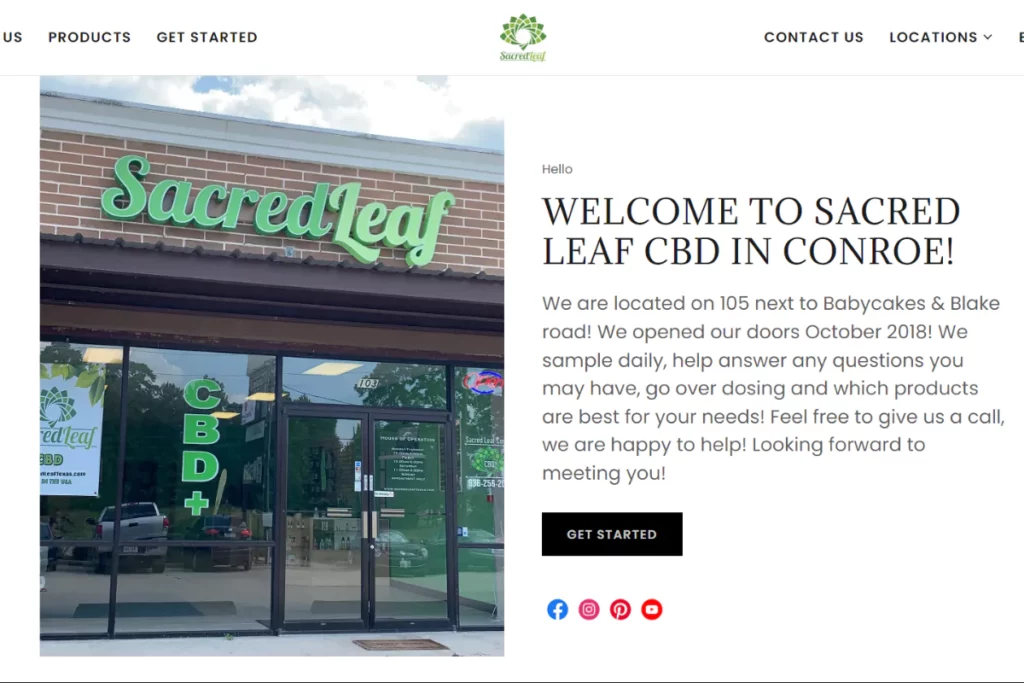
How it works
As with optimizing your GBP, the purpose of building location pages is to rank for queries that indicate someone wants to visit a CBD store in an area where you have a location.
For a query like “cbd store near me” or “cbd store [your city],” your goal will be to rank in the Map Pack with your GBP AND in the regular blue-link search results with a location page.
By showing up twice for these valuable queries, you’ll occupy more visual real estate on the search engine result page (SERP) and increase the chance that someone searching these terms visits you instead of a competitor.
While having two rankings, alone, can be an authority signal, you’ll want to put time and effort into ensuring these pages make a good first impression on people: they should show off your CBD stores and give people a reason to visit you.
How to do it
There are two primary steps to creating your location pages: choosing keywords and building the pages.
1. Choose keywords
You’ll want to create a location page for each one of your brick-and-mortar CBD stores.
The keywords you’ll target with these pages typically follow this pattern:
- “cbd [location of your store]” or “cbd store [location of your store]”
- CITY EXAMPLE: “cbd store plano tx”
- NEIGHBORHOOD EXAMPLE: “cbd store french quarter”
Generally, the right keyword will be intuitive. However, you’ll want to research these keywords to ensure they really do indicate someone wants to visit a CBD store and that they’re a good opportunity for your brand.
This extra bit of research is valuable, because in some cases, you might have better luck ranking for neighborhood search terms than city search terms).
Here’s the process I use to find the best-fit keyword for each location page:
- Input different variations of your keyword into a keyword research tool like SEMrush
- Filter by lowest competition/difficulty score
- Put keyword ideas into your spreadsheet
- Check the search results for each keyword and throw away that ones that don’t return CBD store location pages or home pages
- Of the remaining keywords, choose the one with the best balance of high volume and low competition
2. Build your pages
With keywords in mind, it’s time to build your location pages.
If you have many locations, to save time, I recommend creating a page template which you can then customize for each location.
Generally speaking, each location page should have:
- Contact information (NAP + website)
- Products and store features available at the location
- Map and directions
- Parking information
- Plenty of images, preferably with people
- Hours of operation
- Reviews
- Frequently asked questions
To ensure your page is optimized for SEO, do the following:
- Add your keyword to the page’s SEO title and meta description (which display in the search results). Besides including your keyword, use the title and meta to convey the key benefits of each of your stores (e.g. briefly mention what categories of products you offer).
- Make the H1 heading on the page your keyword (preferably) or a close match.
- Include your keyword and related keywords throughout your page, naturally.
- Answer the questions that appear in the people also ask box for your target keyword.
Pillar 4: Blog Content
Writing helpful SEO-focused blog content helps your CBD store grow its topical authority, which improves the ranking of your GBP and allows you to rank for lucrative, competitive search terms.
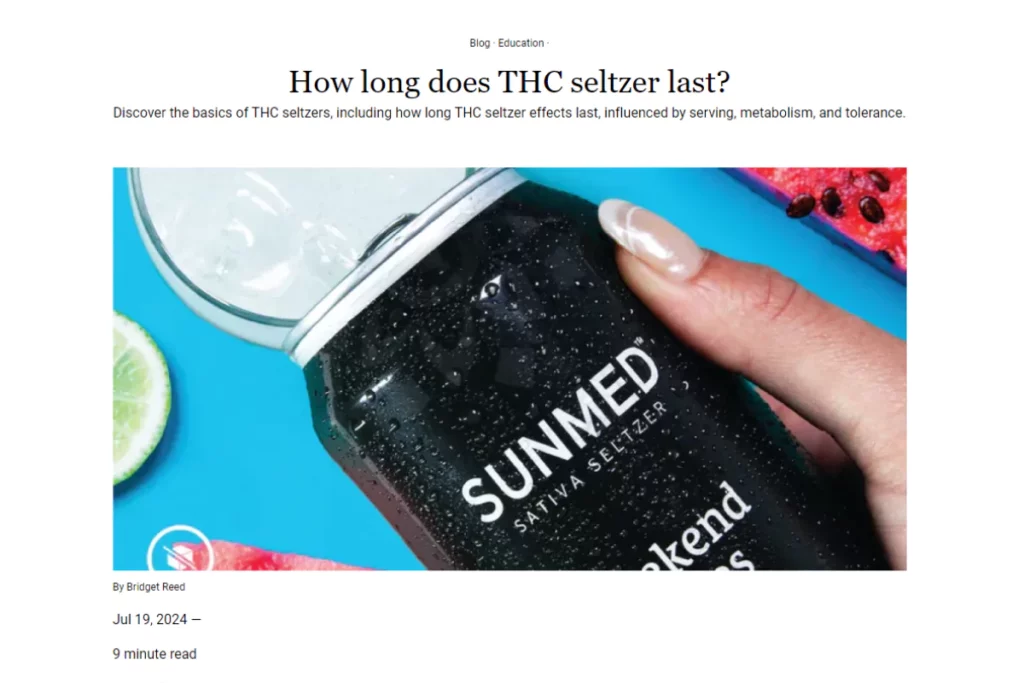
How it works
The main benefit of blog content for brick-and-mortar CBD stores is that it increases your site’s topical authority.
Google prefers to rank sites for a given keyword that are an authority on the topic of the keyword. By writing about CBD, your site will be seen as an authority on CBD and will therefore rank higher and more quickly for CBD-related local keywords, including valuable visiting intent keywords like “cbd near me.”
If your company sells online, too, blog content has a host of additional benefits.
While I said I wouldn’t dive into national SEO here (it really would be way too long), I will briefly mention that blog content helps your product category and product pages rank higher, and it helps you build your email list, which you can transform into a revenue-driving asset with a good email marketing strategy.
That said, topical authority, alone, renders blogging a valuable tactic for the CBD industry.
How to do it
Using blog content to build topical authority entails two main things: choosing the right keywords and creating good content.
1. Choose keywords
While there are quite a few factors you’ll want to consider when choosing blog topics, at a basic level, any keyword you’re targeting should meet three criteria:
- Maps to the products you sell (so you’ll build useful topical authority).
- Has decent monthly search volume – to start, I recommend keywords with 50-100 searches per month starting out (so you’ll get traffic if you rank).
- Has reasonably low competition – to start, I recommend a difficulty score (via an SEO tool) of 30 or under to start (so you can rank in a reasonable time frame).
You’ll want to use your product line to come up with topic ideas, then you’ll want to use keyword data to validate and prioritize these ideas.
Start by imagining each type of product you sell as a topic. Let’s say you sell CBD gummies, CBD oil, and CBD vapes.
From there, think about the main subtopics under each of these head topics. For CBD gummies, a few subtopics might be:
- Can you fly with CBD gummies?
- CBD vs. THC gummies
- How much do CBD gummies cost?
As you go, write down your topic ideas in a spreadsheet. You can use this sheet to collect additional ideas, then prioritize them all.
Once you come up with some basic ideas, check them in a keyword research tool to ensure they fit search volume and competition criteria. If they don’t, look at sub-sub-topics (use your imagination and your tool).
By thinking hierarchically, you can uncover topics that are easier to rank for, but will still help build your site’s authority.
Finally, prioritize. To build authority, I recommend you write all the articles that correspond to a specific product category at the same time – write all 5 of your CBD gummies articles first before you move on to CBD oil, for example.
2. Write content
Instead of giving you an exhaustive list of steps to write and publish CBD content, I’m going to focus on three key pieces of advice that will help your content outperform 90% of what’s out there:
- Do a SERP analysis. The easiest way to write content that ranks is to reverse-engineer what’s already ranking for your target keyword. This will tell you which subtopics people typically want to read about when they search for your keyword – in other words, exactly what you need to discuss to rank. Use this information to build a skeleton outline for your article, then, improve the structure and add unique insights. That’s how you not only rank, but rank #1.
- Research your article thoroughly. Most brands regurgitate information from existing articles instead of bringing unique insights to the table. This presents you an easy opportunity to outdo them. Interview subject-matter-experts from within your company (or maybe you’re a subject-matter-expert), incorporate scientific research, and incorporate anecdotal insights from your customers and platforms like Reddit, Quora, and Twitter. Do this, and your content will be more informative and interesting than most existing content.
- Embellish your article. After you’ve written an article that’s better-optimized and more informative than most other brands’, take it a step further by adding custom images and graphics, as well as YouTube videos. Apart from the brand-affinity benefits it brings, this will increase the amount of time people stay on your site, which contributes to your ranking.
For a complete step-by-step breakdown, see our CBD content writing guide.
Pillar 5: Link Building
Building backlinks to your site on a regular basis helps you increase your authority over time, which gives you a better shot at ranking your GBP in the top three and ranking in the regular results for valuable keywords.

How it works
Google perceives backlinks as votes of confidence. The more links you have from sites relevant to yours, the more trustworthy you’re perceived to be.
And the more trustworthy you are, the more willing Google is to rank your CBD store for lucrative, highly competitive queries, both in the Map Pack and in the regular results.
How to do it
Building backlinks requires two basic steps: choosing a method(s) and performing the necessary outreach to make that method(s) work.
1. Choose a method
When it comes to building links in the cannabis industry, you have three main options:
- PR. Using platforms like Source of Sources, Qwoted, and SourceBottle, you can respond to journalists and bloggers seeking sources with information they need. This offers you an opportunity to respond to these requests with a pitch and some information. If they accept your pitch, you might get a backlink.
- Bloggers. Reaching out to CBD and cannabis-focused bloggers and offering something in exchange for a backlink (e.g. a guest post) is an effective way to get relevant backlinks.
- Partnerships. Offering something to a company in the CBD niche that isn’t a direct competitor is another way to get highly-relevant and valuable backlinks.
2. Perform outreach
Once you select a method, you’ll need to perform outreach using that method on a regular basis.
If you’re using PR platforms, which usually send journalist requests on a daily basis, you’ll need to monitor your inbox and respond to pitches as they come.
If you go the blogger or partnership route, set a schedule for reaching out to eligible sites.
Pillar 6: Technical SEO
Technical SEO is the process of improving your website’s architecture to help Google find, crawl, and index your pages.
The architecture of your website is the foundation of everything you do in SEO, so getting it right is important before you begin building lots of pages and scaling up the size of your site.

How it works
Having a clean website architecture allows Google’s robots to easily find, crawl, and index all the pages on your site. A page can only rank if it’s first been indexed.
Generally, most website platforms and builders create technically sound sites out-of-the-box, so technical SEO isn’t a big problem for most CBD stores.
That being said, if you’re kicking off an organized SEO effort, you’ll want to check for and fix major issues if they do exist so that the investments you make in other areas end up paying off.
How to do it
There’s a seemingly endless list of technical SEO fixes you can make, and many of the things that SEO tools identify as “errors” don’t impact search performance in any meaningful way.
Because of this, I’m only going to cover the issues that have the biggest implications from an SEO standpoint (for a more comprehensive list, I recommend this article).
You can use an SEO tool to find and fix:
- Broken links. Not only are they unhelpful to users; if you’re linking to pages that no longer exist or have had their URL changed, the performance of the page that links out can be negatively impacted. This is because Google will see the page as being poorly maintained.
- Redirect chains. These offer a poor user experience and are easy to fix; simply cut out the “middleman” URLs and redirect the original broken URL directly to the final page.
You can use Google Search Console to find and fix:
- Pages that are discovered, but not indexed. Check this section for URLs that should be indexed. If Google has crawled and discovered your page but isn’t indexing it, chances are, it’s because the content is thin and unhelpful. Fixing or deleting these pages is important because bad pages lower your site’s overall quality as judged by Google and hold back good pages from ranking.
- Duplicate pages without a user-selected canonical. Canonical means original or preferred. Pages in this section are those that Google thinks are duplicates of other pages on your site. When this happens, Google chooses which page is the original and often redirects the non-canonical to the “original” URL. What you’ll need to do here is differentiate the pages enough so Google no longer views them as duplicates. Again, this issue can cause content to effectively be blocked from ranking and driving results until you fix it.
How Long Does it Take to See Results from CBD Local SEO?
If you focus on optimizing your Google Business Profile(s) and building key location pages, you can begin seeing an uptick in foot traffic from search in just 1-2 months. Sometimes you can even see early results in a matter of weeks.
However, you’ll need to wait at least 3-4 months to begin seeing a significant ROI on local SEO, whether you’re paying for services or putting in the hours yourself.
Takeaway: Don’t Just Do Local SEO, Go National
In this article, I’ve laid out a framework that will help your CBD store dominate local search queries that drive foot traffic.
But chances are, you don’t just want to make money from your brick-and-mortar stores: you also want to make money selling your products online.
If that’s the case, you’ll want to invest in “national” SEO, too, which focuses on ranking your product category and individual product pages for search terms that indicate people want to buy these things online. See our CBD SEO strategy article for more.
How to Learn More or Work With Our CBD SEO Agency
- Our services. We offer revenue-focused CBD SEO services to businesses looking to grow their top line revenue and improve their profit margins. We help CBD businesses dominate nationally and locally, and we’d love for you to be our next success story.
- Our blog. A collection of articles that will help you grow your cannabis or CBD business with SEO.
- Our YouTube channel. Videos detailing SEO strategies and tactics to help cannabis and CBD businesses grow.
- Our LinkedIn. SEO and marketing insights for cannabis brands six times a week, straight from Wells, our founder (that’s me).




